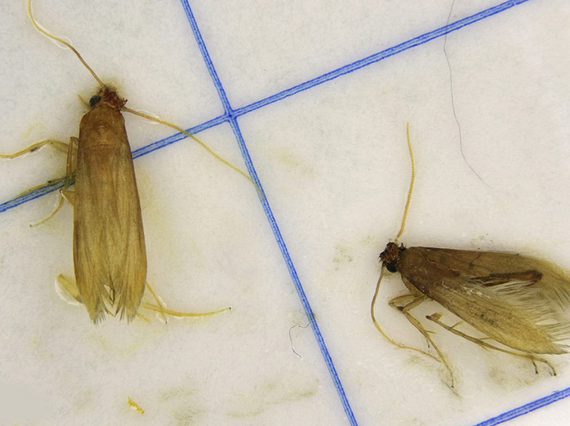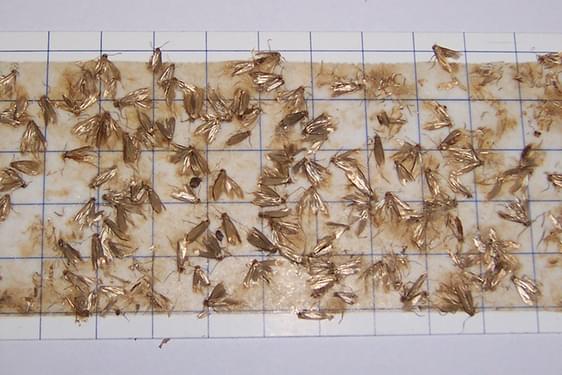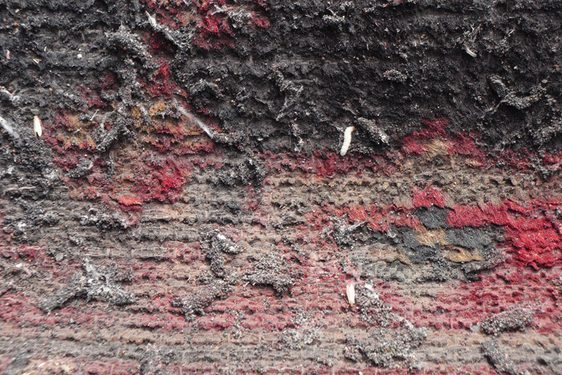
How to identify pests
- This training is for
People who care for heritage collections
- Level
Beginner
- How to complete the training
Follow the sections below in order, read the added resources and watch the videos
What is a museum pest?
We can describe a museum pest as an animal that will in some way cause harm to museum collections. Broadly speaking we’re looking at rodents, birds and insects.
Rodents
Rodents can cause damage by gnawing and chewing as well as with their faeces and urine. The bodies of dead rodents can also provide a food source for insects that may go on to infest collections. If you suspect you may have a rodent problem, please speak to a qualified pest contractor.
If you are employing a pest contractor to treat any pests in your collection, refer to How to deal with infestation for guidance as a pest contractor may not be used to dealing with historic objects where we must consider the long-term implication of adding any chemical to the environment around it.
Bats
If bats are present you should seek advice from NatureScot (previously Scottish Natural Heritage). They have useful information on their website.
If you need to carry out pest treatments for other species and bats are present, there are certain restrictions that must be considered.
Birds
Birds can be problematic as insects are attracted to their nests. This can be particularly problematic where there is access between nesting areas and collections. For example, a chimney, where insects can move from nests to collections. Bird faeces, apart from being a health and safety issue, can also be a collections care problem, harbouring insects or if in contact with objects causing chemical damage.
Guidance for identifying pests
This section outlines the types of insects that can cause damage to collections. These species are many and varied.
Generally, insects that cause harm are under 1cm in length, and it is when they are in the larval stage that damage is caused. However, they are more visible as adults.
Click to expand each section below to learn more about these pests, their features and lifecycle:
Furniture Beetle (Anobium punctatum)
Key features
Dark brown, 3-5mm long, damage caused by larva eating wood in tunnels as it grows.
This beetle can be distinguished from similar looking beetles by its 'hooded helmet’ head, which is visible from the side.
Adult beetles emerge during spring and summer and, as they are attracted to daylight, can often be found on windowsills.
Lifecycle
Adult beetles lay eggs in the crevices of wood, the egg hatches into larva which begins to eat into the wood. The larva grows (taking anything up to 5 years to mature, depending on the ambient temperature), eating a tunnel through the wood.
When it’s grown the larva pupates in its tunnel near the surface of the wood. The adult beetle emerges leaving characteristic holes known as flight holes or exit holes. Furniture beetle require a RH above 60% to thrive and are unlikely to survive in modern dry centrally heated houses. Any infestation is likely to be limited to damper buildings or areas.
Damage
As well as the characteristic holes there may also be frass present, which has the look of sawdust. This may be present on the object or possibly in piles underneath, if beetles have emerged on the underside of an item.
Remember, the larva has made a tunnel by eating through the wood. The physical structure of the wood may have been severely weakened by this damage. Many older pieces of furniture may have old signs of furniture beetle damage such as flight holes.
It is important to check whether an infestation is active or historic we speak more about this later. If objects have signs of damage handle with care.
Image caption: Furniture Beetle (Anobium punctatum) with distinctive hood.
Other Wood Borers
In addition to furniture beetle described above, there are other wood borers such as:
- Death watch beetle
- Longhorn beetles
- Wood weevils
- Powder post beetles
- Termites
Death watch beetles can be found in the historic timbers of properties, leaving an exit hole of around 4mm. However, these are not commonly found in Scotland.
The other beetles are more likely to be found in fresh and/or damp timber rather than dry, historic wood.
Carpet Beetles
Key features
Covered in grey, gold and white scales, small (only 2-3mm in length).
The larvae, which are fat and hairy, are commonly known as woolly bears.
Carpet beetles can be associated with birds’ nests, demonstrating the necessity of good housekeeping, as once established they can be very difficult to eradicate.
Lifecycle
The eggs hatch into larvae, which will feed on keratinaceous material. The larvae will grow to about 5mm long shedding their skins as they get bigger. When grown the larvae will pupate and the adult beetle will emerge.
Damage
Carpet beetles will damage materials including fur, feathers and woollen textiles. As well as damage it may be possible to spot larvae, adult beetles and cast larval skins.
Two Spotted Carpet Beetles (Attagenus pellio)
Key features
Black with two distinctive white spots, about 5mm long.
The larvae which can grow up to 10mm in length, are covered in hairs and are torpedo shaped.
Damage
The larva can cause damage to, amongst other items, insect collections, mammal and bird skins and woollen textiles.
Common (or Webbing) Clothes Moth (Tineola bisselliella)
Key features
A uniform gold/fawn colour with a red tuft on its head, about 5-7mm long. The adult moths prefer dark to light areas, making museum stores an ideal place for them.
Lifecycle
The adult lays eggs on fur, feathers, skins, wool or other keratinaceous material. The eggs develop into larvae which are cream coloured with a brown head capsule. As the larvae grow they spin webbing, which allows them to trap moisture. The larvae pupate, and the adult moth emerges.
Damage
The larvae will eat through keratin-based materials, favouring softer textiles and feathers where they can get them. Damage is often hidden in darker areas, in pockets or behind lapels. As well as damage to the object there may also be larvae, adult moths, pupae cases (often in creases on textiles and upholstery) webbing and frass.
The moth webbing appears as a fine white trail across the object, and the moth frass is about 1mm in diameter, and can be the colour of the textile that has been eaten.
Case-bearing Clothes Moth (Tinea pellionella)
Key features
Grey/fawn coloured with darker patches on its wings, about 5mm long.
Lifecycle
The adult lays eggs on fur, feathers, skins, wool or other keratinaceous material. The egg develops into a larva which spins a cocoon around itself. It grazes a trail across the item it is feeding on, taking its cocoon with it. The larvae pupate, and the adult moth emerges.
Damage
The larvae eat keratinaceous material. As well as damage there may be larvae, moths and cocoons.
Brown House Moth (Hofmannophila pseudospretella)
Key features
Brown with darker patches or spots on its wings, Brown house moths are about 10mm (larger than webbing clothes moth).
Damage
Less likely to cause damage than the clothes moths, but may cause damage particularly when objects are damp. Found in large numbers they could be cause for concern, but singly they are likely to have made their way in from outside.
Image caption: Brown House Moths (Hofmannophila pseudosprettela) are identifiable by their size and dark markings.
White Shouldered House Moth (Endrosis sarcitrella)
Key features
Brown with patches on its wings and a very distinctive white head and shoulders.
Damage
Less likely to cause damage than the clothes moths, but may cause damage particularly when objects are damp. Found in large numbers they could be cause for concern, but singly they are likely to have made their way in from outside.
Biscuit Beetle (Stegobium paniceum)
Key features
Reddish-brown in colour, only 2-3mm long. This beetle is related to furniture beetle, and has a similar appearance on the wing cases, with indented, dotty lines. However, it does not have the distinctive ‘hooded helmet’ element.
Damage
They will eat materials with a high starch content, for example, papier mâché.
Spider Beetles
There are various spider beetles, so-called due to their spider like appearance with rounded bodies and long legs.
They can damage paper, dried plants, animal skins, textiles and other materials.
They can be taken as an indication that cleaning is required as they will live on dust and debris built up around the edges of the room.
Species of Spider Beetle:
Australian spider beetle (Ptinus tectus)
- Brown, can be mistaken for furniture beetle, but doesn’t’ have the distinctive hooded helmet, 3-5mm long.
White-marked spider beetle (Ptinus fur)
- Brown with distinctive white marks on each side and either end of the wing cases, 3-5mm long.
Golden spider beetle (Niptus hololeucus)
- Golden coloured with a round shape, about 3mm long
Globular spider beetle (Trigonogenius globulus)
- Patchy brown and gold with a globular shape, 3-5mm long
Booklice
Key features
Without any colour, they pick up the colour of dust that they may be living in. They are extremely small, up to about 1mm. There are various species, with and without wings.
Damage
They feed on microscopic moulds and can be found on paper and starchy materials. They thrive at high humidity but need to be present in very large numbers to cause damage. They can be taken as an indication that the environment (damp and dirt) could be improved.
Silverfish
Key features
Silver grey in colour with bristly tails, varying in size up to about 10mm long.
Lifecycle
The silverfish hatches from the egg into a nymph, which has the appearance of a small adult. Some species need a high RH to survive, and they can be taken as an indication of damp.
Damage
They feed on microscopic moulds, glues and inks and can be a pest in damp wallpaper, labels and other paper.
More sections in this training

How to monitor pests
Infestations are much easier and cheaper to deal with if you catch them early.
How to prevent infestation
The best way to prevent infestation is to stop pests entering your collection.
How to deal with infestation
A good way to deal with any possible pest discoveries is to ask a number of questions about what you have found.